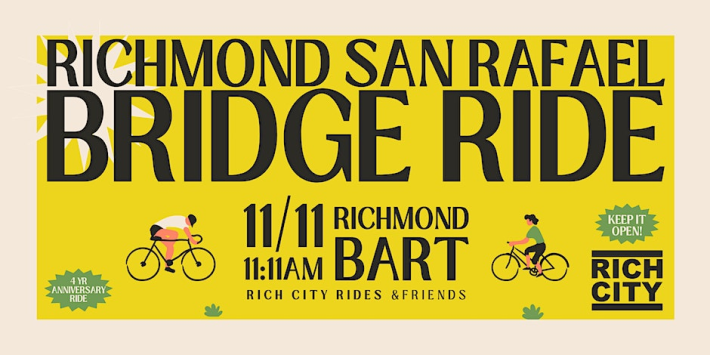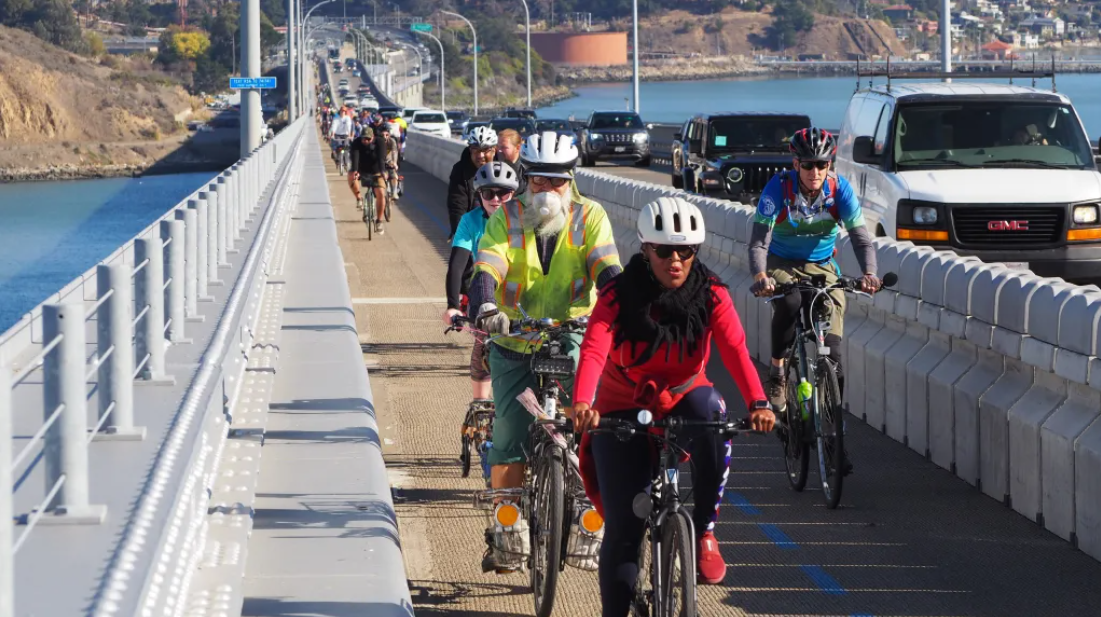"There is no evidence to suggest that the path has resulted in an increase in congestion in the westbound direction," said the Metropolitan Transportation Commission's Lisa Klein during a hearing Wednesday morning to update the status and findings of the bike and pedestrian pilot lane on the Richmond-San Rafael Bridge. "The data indicates that congestion is very similar to what it was before."
Klein was addressing the Bay Area Toll Authority Oversight Committee. Opened in 2019, the lane is part of a pilot and study - the full results of which should come this summer - to look at the effects of turning the shoulder of the upper deck of the bridge (the westbound direction) into a protected bike and pedestrian space.

Although the meeting was just informational (there was nothing to vote on) it acted as an important update and pushback against efforts to abort the bike space and open all six bridge lanes to private automobiles.
Sadly, the facts on the ground about congestion have "been countered by a lot of misinformation," said Bike East Bay's Robert Prinz in his statement during public comment period for the meeting. He said that one group spent "what we think is around $100,000 in ad buys and mailers to Richmond residents making false claims about what is causing bridge congestion, pollution, and other factors that are very clearly disproven in the staff presentation."
That group, the Bay Area Council and "Get the Richmond Bridge Moving," also shamelessly co-opted "equity" concerns by making unsupported assertions that bridge traffic is caused by the bike lane, and that the traffic is causing additional pollution that falls more heavily on nearby minority populations.
"From a health standpoint, the majority of the pollution in the Richmond community is from road dust, brake wear, and tire wear, not exhaust emissions," explained Klein during her presentation. "These emissions correlate with Vehicle Miles Traveled (VMT), rather than congestion."
That means opening yet another lane to traffic, as the Bay Area Council and Get the Richmond Bridge Moving want, will attract more drivers and produce more particulates, increasing pollution.
Nevertheless, this hasn't stopped the the two groups from taking out a full-page ad in the San Francisco Chronicle, in which they shamelessly race-baited to support their cause.
Thank you for your support and the amazing advocacy of our friends at @marinbike
— Rich City Rides (@Rich_rides) November 7, 2023
The ad plays on stereotypes of cyclists being majority rich and white. Streetsblog and other sources have refuted the nonsense in the ad about race many times before. Note the group calls out the Marin County Bicycle Coalition, but not Rich City Rides, the Richmond-based, largely African-American advocacy group that's been a leader in the fight for the bridge's bike lane all along.
We need your #Help to Save the Richmond-San Rafael Bridge trail! Please #Sign & #Share our petition! #RT https://t.co/xYvftFF7ug via @Change #ClimateJustice
— Rich City Rides (@Rich_rides) November 6, 2023
"I’m honestly not sure why Rich City Rides wasn’t referenced, but suspect there was no particular reason," wrote Rufus Jeffris, a spokesman for the Bay Area Council, in an email to Streetsblog.
Meanwhile, the Grandview Independent documented efforts by the Council to rip out the bike path and Rich City Rides's efforts to stop them in "Bicycle advocacy group works to save Richmond Bridge path," by Soren Hemmila. Hemmila points out that the Council has strong connections with the petroleum industry: for example, Chevron's government affairs manager Henry Perea sits on the Bay Area Council's Board of Directors. And the Western States Petroleum Association is a listed member of the Council.
“Individuals should have the right to choose healthy, non-sedentary modes of commuting, promoting their well-being and contributing to a more sustainable and active lifestyle," Rich City Rides executive director Najari Smith told the Grandview Independent. Streetsblog has also reached out directly to Smith and will update this post.
"The congestion issues on the bridge are largely an outcome of land use and housing decisions forcing people into long car commutes," added Prinz. "So they can only be sustainably and equitably resolved via vastly increased workforce housing development in Marin, eliminating the need for many transbay commutes altogether, and by providing greatly expanded public transit service to move more people on the bridge without adding pollution and inducing more driving."
Readers who want to ride the bridge and show their support for the path can do so on Saturday, Nov. 11 at 11:11 a.m. Rich City Rides is hosting an anniversary ride to preserve the path. Roll-out is at noon. Richmond BART, 269 16th Street, Richmond. Register for the ride here.







